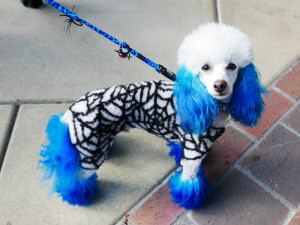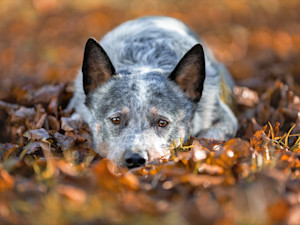4 Ways to Make Sure Your Dog Doesn’t Get Spooked This Halloween
AKA stays safe.

Share Article
It’s October, the month when we humans intentionally scare the daylights out of ourselves. As intensely as we might seek out scariest haunted house or most jump-scare-filled movie out there, our pups want left out of the frights. But when it comes to Halloween, there are some real-life horrors for pet parents to be aware of.
Luckily, there are ways to keep our dogs safe and comfortable during the creepy season. Dr. Katherine Houpt, professor emeritus of behavior medicine at the Cornell University College of Veterinary Medicine, and Dr. Leni Kaplan, a senior lecturer at the Cornell University College of Veterinary Medicine, share some Halloween safety tips to help your pup thrive this holiday.
Choose comfortable dog costumes
The reality is, most dogs probably don’t want to wear a Halloween costume. But if you do choose to dress up your dog, there are some safety measures to keep in mind. First of all, ensure that the costume fits well and isn’t going to slip and tangle up your pet or become a choking hazard if chewed. “Make sure costumes are the appropriate size and fit for your pet. A costume that is too tight will be constricting and uncomfortable, and a costume that is too loose may rub and cause skin irritation. In either case, your pet may have difficulty moving around and will not enjoy their experience,” Dr. Kaplan says.
You’ll also have to consider your dog’s emotional wellbeing; you want the experience to be comfortable and happy for them. “Make the costume a signal that good things are about to happen, like a walk,” Dr. Houpt says. “Another method is to pair a tiny — but delicious — snack with the placement of the costume.”

And never force a dog who doesn’t want to wear a costume into one — no photo op is worth your pet’s happiness. If you want them to show some Halloween spirit, animal behaviorist and trainer Dr. Karen London recommends adding a small adornment around their neck, such as a bowtie, since most dogs are already used to collars.
Dr. Kaplan also recommends steering clear of “costumes with accessories that are easy to grab or pull off — your pet might eat the accessory, predisposing them to a gastrointestinal foreign body obstruction, which will require veterinary medical attention and possible surgery.” As an added safety precaution, never leave a pet in a costume unattended.
Sit out trick-or-treating
There are a lot of extra people on the streets at Halloween, and that, combined with strange costumes, can freak out pets and cause them to bolt. “It is not advised to take your dog trick-or-treating, due to crowds, children, unfamiliar people dressed in unfamiliar outerwear (costumes, masks, and carrying props),” Dr. Kaplan says.
“Dogs who are normally fine in crowds may be scared or spooked, and may act aggressively or out of character. If you do take your pet trick-or-treating, be sure to dress your pet in brightly colored and reflective clothing so they are easy to see at night, and keep them on leash at all times.” Dr. Houpt adds: “Only take your dog out if they have never had a problem with strangers and is restrained on an 8-foot leash, not a retractable or ‘flexi’ leash. Dogs are most likely to react to ghost costumes because the outline of the human is missing.”
Keep candy out of reach
Snacking on Halloween candy is a great time for us humans, but it’s best to keep it far away from your pup. Dr Kaplan warns: “Candy and human snacks can lead to vomiting, diarrhea, dehydration, and in some circumstances pancreatitis, a serious illness which may require hospitalization. Restrict access to foods toxic to dogs such as chocolate, coffee, caffeine, macadamia nuts, grapes, raisins, and any food containing xylitol or psychoactive cannabinoids such as marijuana.” However, she says, “pumpkin is safe for pets to eat as long as it is not moldy. If your pet eats moldy pumpkin, contact a veterinarian immediately.”
Don’t let your pup be a party animal
Even pets who are kept indoors may experience severe stress over the large number of strangely dressed visitors. Keeping your pet away from trick-or-treaters may do the trick, but if you think more will be needed, speak with your vet well in advance about options to help calm your pet.
“During parties or trick-or-treater visits, dogs can be confined in a room with a long-lasting treat or a food-dispensing toy,” Dr. Houpt says. “Play music or white noise so your pet is unaware of the people to keep them calm.”
Use LED to light jack-o-lanterns
“Avoid using real candles, as pets are often drawn to the flickering light and warmth,” Dr. Kaplan says. “They could burn themselves or start a fire if the Jack-o-Lantern is tipped over. Instead of candles, use battery-powered LED candles or glow sticks. And make sure your pet cannot access and eat the LED candles or glow sticks!”

Claudia Kawczynska
Claudia Kawczynska was co-founder and editor-in-chief of The Bark for 20 years. She also edited the best-selling anthology Dog Is My Co-Pilot.
Related articles
![dog with blue dy]()
(Fur) Dye Another Day: Celebrity Groomer Jess Rona on This Halloween Question
When to DIY your dog’s Halloween costume or dye their fur — and when to leave it to the pros.
![Overhead shot of a dog and a broken chocolate bar on the floor]()
The Top 5 Halloween Hazards for Dogs
Scarier than The Conjuring: Last Rites.
![Two female friends in their twenties playing with their dogs outside in autumn.]()
7 Surprising Things Dogs Hate About Halloween
This holiday is chock full of triggers that could scare any pooch.
![black dog wearing a supergirl costume]()
Do Dogs Like Halloween Costumes? How to Dress Them Up So They Don’t Hate It
Even though they probably will.
![Cute dog laying down in the fall leaves outside.]()
10 Things Dogs Actually Hate About Fall
Not everyone loves chunky knits and pumpkin spice lattes.





